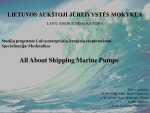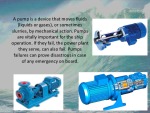Pumps On The Ship



Lietuvos aukštoji jūreivystės. A pump is a device that moves fluids (liquids or gases). The most common types of pumps are the displacement pumps and the. Displacement pumps 1. Gearwheel pump 2. Reciprocating pump 3. Screw pump 4. Vane pump. Centrifugal pumps. A centrifugal pump consists of an impeller and an intake at its center. Axial Flow pumps. Axial flow pumps are also called propeller pump. A jet pump, sometimes called an eductor, is frequently found in an engine room. Jet pumps. Centrifugal-Axial pumps. Often simply referred to as centrifugal pumps. Gearwheel pumps. External gear pumps. Reciprocating pumps. In a reciprocating. Screw pumps. The liquid is. Vane pumps. Vane pumps are used for liquid transfer applications from chemicals to liquefied gases. Thank you for attention.
A pump is a device that moves fluids (liquids or gases), or sometimes slurries, by mechanical action. Pumps are vitally important for the ship operation. If they fail, the power plant they serve, can also fail. Pumps failures can prove disastrous in case of any emergency on board.
The most common types of pumps are the displacement pumps and the dynamic pumps.
Displacement pumps: 1.Gearwheel pump 2.Reciprocating pump 3.Screw pump 4.Vane pump.
Dynamic pumps: 1.Centrifugal pump 2.Axial flow pump 3.Centrifugal-axial (mixed) pump. 4.Jet pumps.
Pumps on ships are used for the following main purposes:.
These pumps are used in engine cooling systems and in a seawater lines.
These pumps are used in ballast systems.
It is used for pumping large quantities of water overboard . Educators make an important part of drainage system and damage control systems.
Vane pumps are used for liquid transfer applications from chemicals to liquefied gases. Vanes extend from slots in the rotor, sweeping liquid through a cam-shaped cavity.
- Engineering Presentations
- MS PowerPoint 2108 KB
- 2016 m.
- English
- 12 pages (435 words)
- School
- Dadec

















